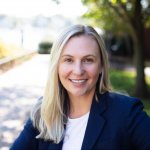Kim Gaddy
Newark, New Jersey
Kim Gaddy is the Environmental Justice Organizer for Clean Water Action of New Jersey. She has been advocating for communities impacted by industrial pollution and the goods movement system in Newark and across the country for 18 years. Kim develops and implements Clean Water Action/Clean Water Fund’s grassroots environmental justice campaigns and coalition-building efforts in New Jersey. She is a former Newark School Board Member, New York/New Jersey Regional Representative for the Moving Forward Network, Port Commissioner for the City of Newark, Appointed by Governor Phil Murphy to serve as Vice-Chair of the NJDEP’s Environmental Justice Advisory Council, former Chair of both the Newark Environmental Commission and the Essex County Environmental Commission, a founding member of the New Jersey Environmental Justice Alliance and New Jersey President of the International Black Women’s Congress. Previously, she worked in municipal government in Newark for 12 years and served as the first female Chief of Staff, for Councilwoman Mildred Crump. Kim has been recognized in the 2018 book Newark Women: From Suffragettes to the Statehouse. In 2017, Kim was profiled in 100 People of Newark, Women on the Move and, in 2007, Kim received the EPA Region 2’s Environmental Champion Award.
This interview was conducted by Carly Schmidt on September 17, 2019. Learn more about Kim’s work at Clean Water Action of New Jersey.
What is your current role at Clean Water Action and how did your experience growing up lead you to where you are today?
I am the environmental justice organizer for Clean Water Action. I have been with Clean Water Action for 18 years now. Prior to me transferring from municipal government work, my godson was diagnosed with lead poisoning related to lead paint chips. He was in the 1st grade and would have irreversible brain damage. This experience got me thinking about lead in the city of Newark. I was working for the Newark Board of Education 23 years ago and I got to talking to parents about similar experiences with lead poisoning and the connection to water. We decided to test the school and found high levels of lead, so we had to turn off all fountains in the school system. Fast forward a couple years, my daughter, at the age of 1, was diagnosed with asthma. This was a turning point and I knew that I had to work on environmental justice full time and mitigate this connection between environmental degradation and communities of color. Now I work to have discussions around how we can begin to fight and change what is happening in these communities.
You have been involved in environmental justice work for a long time. What issues are at the forefront of your work today?
Today I am still working on lead issues, specifically drinking water and the condition of pipes going into people’s homes. I do a lot of work educating people about their homes and the need to replace pipes. For example, people are not informed about how to use lead filters. They don’t know how to place a filter on their faucet, what it means when the colors change and how to replace the cartridge. We are working with community activists and the city to ensure that the proper information is provided to residents to they have the knowledge and tools to protect their families.
Unfortunately, on August 13, two of three filters failed, so the EPA and DEP decided that the 18 thousand people impacted need to be placed on bottled water. We are now campaigning to take back the tap. People in our community don’t trust tap water, so we have to change our message to educate people about the importance of running their tap water. In Newark, the lead corrosion inhibitor failed so lead was flaking in pipes. Our solutions will only run properly if households run their water, but the city told residents not to use their taps so they’re not turning on their kitchen sink. This will ultimately push back the process of correcting the system. We’ve been working with Believe in a Healthy Newark to educate people about this process so we can get back to healthy drinking water. But we are in a delicate position because once the letter came from EPA, many households stopped using tap water altogether and some even threw out their filters.
We are also working in Trenton, New Jersey, on similar lead issues. Canvassers are going door to door educating residents about letting the water run and replacing service lines. It is most important to train up the local residents to be voices for the community. We have two cities working on lead issues. It’s a national crisis because of aging infrastructure in so many municipalities.
Lead is such a prevalent issue across the country. What do you think Clean Water Action does particularly well in addressing these issues?
Clean Water Action is a grassroots organization that goes out every night canvassing for the organization. We work to train up residents to give them the best information and practices to communicate effectively with their neighbors. A door-to-door canvassing team is what we were founded on and it’s crucial to our organization. A lot of organizations don’t have the capacity to send out professionally trained canvassers and deliver their message in that way. This is a major strength of Clean Water Action.
Another strength is our train the trainer model. It’s not just about the homes. We go into community-based institutions like daycare centers and train providers to be knowledgeable and provide the same information to parents. In terms of educating the community, we strive to be very visual and hands-on. For example, showing someone a lead filter is more powerful than having them read about it. They can see the problem, relate to it and speak the message. We are giving the most vulnerable communities the tools to change their situation.
You have a long-standing relationship with River Network, mainly our programs staff working in the Drinking Water Cohort. What was that experience like?
When you work in this kind of collaborative group, with individuals who have specific expertise and knowledge, you can hear their stories and it helps shape your own message. I learned a lot from the members of this cohort and looked to their strategies to inform my own plans. I was able to listen and hear from other community experts about what worked for them, what didn’t work for them, and how they implemented their plans. Sometimes you get accustomed to doing things your way until someone shows you a better way. Learning from cohort members who had been in a similar situation as us helped us change for the better.
Have you been able to use any of the knowledge you obtained through the Drinking Water Cohort in your work in New Jersey?
One thing I brought back is a reinforcement of the understanding that local people are the experts. You have to find a way to hear them and help them change their situation. In Newark, we want to really work and be successful at establishing sound collaborations. Sometimes you work with the same people for so long that you think you’re being really effective. Participating in the drinking water cohort made me revisit how I was participating in these collaborations. To be really effective, you have to go around the table, learn about each person’s goals and come to an understanding about collective desired outcomes. In many situations, some people are moving forward and some are left behind. We need to better ensure that everyone has success and is getting the education and services they need.
What kind of impact would you like to see your organization make in your community over the next 10 years?
I want residents of Newark and throughout New Jersey to have access to clean, safe, and affordable drinking water coming directly out of their tap. I hope in 10 years we can have trust in our local government and water authorities, but above all I hope that our communities trust in themselves to be their own advocates. We always strive to speak for the voiceless, or those who are most vulnerable to environmental degradation. To achieve our goal of clean, safe, and affordable drinking water, these people have to stay in the fight and work as a collective body within the community. Overall, our communities should be able to trust in our leadership but also have the knowledge and skills to verify information on their own. I want a vibrant and strong community that understands their value and that they are the best advocates for the challenges they are facing.







